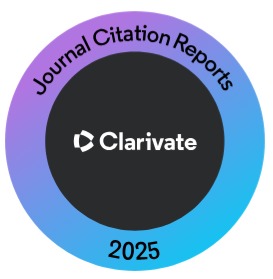A Systematic Review on Relationship of Bisphenol-A with PCOS, with a focus on Pakistan
Keywords:
polycystic ovarian syndrome, PCOS, Bisphenol-A, EDCs, PakistanAbstract
The study was done to show the association of high bisphenol-A levels with polycystic ovarian syndrome, keeping Pakistan in focus. Google Scholar, PubMed, ScienceDirect, and DOAJ were used for the literature search. Original research articles from 2018 to 2023 were included in this review. A total of 86 articles were extracted. After exclusion, fourteen (16) articles were included in the review. No human studies were found in Pakistan, the USA, Canada, Australia, or Europe. All studies included in the review were case-control studies. Most of these studies (14) showed a positive relationship between BPA levels and PCOS, but two studies could not. No animal or human studies were found in Pakistan. Only one study was found in humans in Pakistan, which showed a direct relation between BPA levels in urine and insulin resistance in diabetic patients. According to global studies, BPA was a possible etiological factor for PCOS. No such data was obtained from Pakistan, but evidence of high levels of BPA in tap water and various canned and bottled drinks in Pakistan was found. BPA should be considered an actual threat in Pakistan at the national level. So, studies must be done, and regulations must be made to control BPA use.
References
Liu J, Wu Q, Hao Y, Jiao M, Wang X, Jiang S et al. Measuring the global disease burden of polycystic ovary syndrome in 194 countries: Global Burden of Disease Study 2017. Hum Reprod. 2021; 36(4): 1108-1119. doi:10.1093/humrep/deaa371.
Adullhameed SM, Abdelhafez AA, ElAzab DR, Alseraty WH. Effect of lifestyle changes intervention on quality of life and self-esteem of adolescent female with polycystic ovary syndrome. Int Egypt J Nurs Sci Res. 2022; 2(2): 524-533. doi:10.21608/ejnsr.2022.212564
Lone, Munawar N, Babar S, Sultan S, Malik S, Nazeer K, Riaz S. Association of the CYP17 and CYP19 gene polymorphisms in women with polycystic ovary syndrome from Punjab, Pakistan. Gynecol Endocrinol. 2021; 37(5): 456-461. doi:10.1080/09513590.2020.1822803.
Singh S, Pal N, Shubham S, Sarma DK, Verma V, Marotta F et al. Polycystic Ovary Syndrome: Etiology, Current Management, and Future Therapeutics. J Clin Med. 2023; 12(4): 1454. doi:10.3390/jcm12041454.
Akash MSH, Sabir S, Rehman K. Bisphenol A-induced metabolic disorders: From exposure to mechanism of action. Environ Toxicol Pharmacol. 2020; 77: 103373. doi:10.1016/j.etap.2020.103373.
FAO, WHO. Toxicological and Health Aspects of Bisphenol A. FAO, WHO; 2010.
Riaz A, Pasha I, Sharif MK, Javaria S. Bisphenol A and its Analogues: Human Exposure and Biological Effects - A Review. Pak J Sci Ind Res. 2021; 64(2): 173-190. doi:10.52763/PJSIR.PHYS.SCI.64.2.2021.173.190.
Zhan W, Tang W, Shen X, Xu H, Zhang J. Exposure to bisphenol A and its analogs and polycystic ovarian syndrome in women of childbearing age: A multicenter case-control study. Chemosphere. 2023; 313: 137463. doi: 10.1016/j.chemosphere.2022.137463.
Kawa IA, Masood A, Ganie MA, Fatima Q, Jeelani H, Manzoor S et al. Bisphenol A (BPA) acts as an endocrine disruptor in women with Polycystic Ovary Syndrome: Hormonal and metabolic evaluation. Obes Med. 2019; 14: 100090. doi:10.1016/j.obmed.2019.100090.
Prabhu NB, Vasishta S, Bhat SK, Joshi MB, Kabekkodu SP, Satyamoorthy K et al. Distinct metabolic signatures in blood plasma of bisphenol A–exposed women with polycystic ovarian syndrome. Environ Sci Pollut Res Int. 2023; 30(23): 64025-64035. doi: 10.1007/s11356-023-26820-w.
Rutkowska A, Olsson A, Wilczewska K, Laczmanski L, Kuliczkowska-Plaksej J, Jedrzejuk D et al. Bisphenol A impacts hormonal profile in patients with polycystic ovary syndrome but not in healthy women. Gyneacol Reprod Endocrinol Metabol. 2020; 1(1): 43-47. doi: 10.53260/grem.201018.
Akgül S, Sur Ü, Düzçeker Y, Balci A, Kizilkan MS, Kanbur N et al. Bisphenol A and phthalate levels in adolescents with polycystic ovary syndrome. Gynecol Endocrinol. 2019; 35(12): 1084-1087. doi: 10.1080/09513590.2019.1630608.
Konieczna A, Racho? D, Owczarek K, Kubica P, Kowalewska A, Kudlak B et al. Serum bisphenol A concentrations correlate with serum testosterone levels in women with polycystic ovary syndrome. Reprod Toxicol. 2018; 82: 32-37. doi: 10.1016/j.reprotox.2018.09.006.
Milanovi? M, Miloševi? N, Sudji J, Stojanoski S, Krstonosic MA, Bjelica A et al. Can environmental pollutant bisphenol A increase metabolic risk in polycystic ovary syndrome? Clin Chim Acta. 2020; 507: 257-263. doi:10.1016/j.cca.2020.05.009.
Lazúrová Z, Figurová J, Hubková B, Mašlanková J, Lazúrová I. Urinary bisphenol A in women with polycystic ovary syndrome – a possible suppressive effect on steroidogenesis? Horm Mol Biol Clin Investig. 2021; 42(3): 303-309. doi: 10.1515/hmbci-2020-0032.
Shaheed HS, Abbas WA, Jasim SY. Correlation between Serum Bisphenol-A Level, Luteinizing Hormone (LH), Follicular Stimulating Hormone (FSH) In a Sample of Iraqi Women with PCOS. Int J Pharmaceut Res Scholars. 2020; 13(01): 1963-66. doi: 10.31838/ijpr/2021.13.01.290.
Elkafrawy ME, Ahmed HF, Effat DM, Ahmed AAM, Barghash SSM, Elbrahim G. Environmental Exposure of Bisphenol a and its Association with Polycystic Ovary Syndrome (PCOS) and Depletion of Ovarian Reserve among Infertile Women. Int J Curr Res. 2018; 10(12): 76913-18.
Chowdhury E, Banu H, Morshed MS, Hasanat MA. Elevated Serum Bisphenol A Levels may be Linked to Adverse Reproductive Characteristics of Women with Polycystic Ovary Syndrome. Conference: 3rd University Research Day, 2021 (Bangabandhu Sheikh Mujib Medical University) At: Dhaka, Bangladesh. Affiliation: Bangabandhu Sheikh Mujib Medical University. Published online 2021. doi:10.13140/RG.2.2.21598.15681.
Jafar AK, Rasheed IH, Tektook NK. Correlation between serum bisphenol A and testosterone levels in women with polycystic ovary syndrome. J Univ Shanghai Sci. 2022; 24(1): 389-400.
Fathy M, Elgazzar A, Alalfy M, Alrashed MA, Abdalmageed A, Greash MA et al. Correlation Study of Urinary Bisphenol-A in a Sample of Egyptian Women with Polycystic Ovary Syndrome. Egypt J Forensic Sci Appli Toxicol. 2022; 22: 145-155.
Simkova M, Vítk? J, Kolátorová L, Vrbikova J, Vosatkova M, Vcelak J et al. Endocrine disruptors, obesity, and cytokines - how relevant are they to PCOS? Physiol Res. 2020; 69(Suppl 2): S279-S293. doi:10.33549/physiolres.934521.
Gu J, Yuan T, Ni N, Ma Y, Shen Z, Yu X et al. Urinary concentration of personal care products and polycystic ovary syndrome: A case-control study. Environ Res. 2019; 168: 48-53. doi:10.1016/j.envres.2018.09.014.
Jurewicz J, Majewska J, Berg A, Owczarek K, Zajdel RA, Kaleta D et al. Serum bisphenol A analogues in women diagnosed with the polycystic ovary syndrome - is there an association? Environ Pollut. 2021; 272: 11562. doi: 10.1016/j.envpol.2020.115962.
Tay CT, Hart RJ, Hickey M, Moran LJ, Earnest A, Doherty DA et al. Updated adolescent diagnostic criteria for polycystic ovary syndrome: impact on prevalence and longitudinal body mass index trajectories from birth to adulthood. BMC Med. 2020; 18(1): 389. doi: 10.1186/s12916-020-01861-x.
Scarfò G, Daniele S, Fusi J, Gesi M, Martini C, Franzoni F et al. Metabolic and Molecular Mechanisms of Diet and Physical Exercise in the Management of Polycystic Ovarian Syndrome. Biomedicines. 2022; 10(6): 1305. doi: 10.3390/biomedicines10061305.
Farooq MU, Jalees MI, Qurat-ul-Ain, Hussain G, Anis M, Islam U. Health risk assessment of endocrine disruptor bisphenol A leaching from plastic bottles of milk and soft drinks. Environ Sci Pollut Res Int. 2021; 28(40): 57090-57098. doi: 10.1007/s11356-021-14653-4.
Taskeen A, Hameed R, Naeem I. Sources of Bisphenol A Contamination in Drinking Water in Pakistan and Determination of Migration Rates. Biomed Pharmacol J. 2012; 5(2): 235-240. doi: 10.13005/bpj/349.
Haq MEU, Akash MSH, Sabir S, Mahmood MH, Rehman K. Human exposure to bisphenol A through dietary sources and development of diabetes mellitus: a cross-sectional study in Pakistani population. Environ Sci Pollut Res Int. 2020; 27(21): 26262-26275. doi: 10.1007/s11356-020-09044-0.
Faheem M, Khaliq S, Ahmad HU, Lone KP. Bisphenol-A (BPA) Alters Plasma Thyroid Hormones and Sex Steroids in Female Pakistani Major Carp (Catla catla; Cyprinidae). Pak Vet J. 2017; 37(3): 326-330.
Dobrescu A, Nussbaumer-Streit B, Klerings I, Wagner G, Persad E, Sommer I et al. Restricting evidence syntheses of interventions to English-language publications is a viable methodological shortcut for most medical topics: a systematic review. J Clin Epidemiol. 2021; 137: 209-217. doi: 10.1016/j.jclinepi.2021.04.012.
Vagi SJ, Azziz-Baumgartner E, Sjödin A, Calafat AM, Dumesic D, Gonzalez et al. Exploring the potential association between brominated diphenyl ethers, polychlorinated biphenyls, organochlorine pesticides, perfluorinated compounds, phthalates, and bisphenol a in polycystic ovary syndrome: a case–control study. BMC Endocr Disord. 2014; 14: 86. doi: 10.1186/1472-6823-14-86.
Palioura E, Diamanti-Kandarakis E. Polycystic ovary syndrome (PCOS) and endocrine disrupting chemicals (EDCs). Rev Endocr Metab Disord. 2015; 16(4): 365-371. doi: 10.1007/s11154-016-9326-7.
Ougier E, Zeman F, Antignac JP, Rousselle C, Lange R, Kolossa-Gehring M et al. Human biomonitoring initiative (HBM4EU): Human biomonitoring guidance values (HBM-GVs) derived for bisphenol A. Environ Int. 2021; 154: 106563. doi: 10.1016/j.envint.2021.106563.
Frankowski R, Zgo?a-Grze?kowiak A, Grze?kowiak T, Sójka K. The presence of bisphenol A in the thermal paper in the face of changing European regulations – A comparative global research. Environ Pollut. 2020; 265: 114879. doi: 10.1016/j.envpol.2020.114879.
Jarrett BY, Vanden Brink H, Oldfield AL, Lujan ME. Ultrasound Characterization of Disordered Antral Follicle Development in Women with Polycystic Ovary Syndrome. J Clin Endocrinol Metab. 2020; 105(11): e3847-e3861. doi: 10.1210/clinem/dgaa515.
Kechagias KS, Semertzidou A, Athanasiou A, Paraskevaidi M, Kyrgiou M. Bisphenol-A and polycystic ovary syndrome: a review of the literature. Rev Environ Health. 2020; 35(4): 323-331. doi: 10.1515/reveh-2020-0032.
Priya K, Setty M, Babu UV, Pai KSR. Implications of environmental toxicants on ovarian follicles: how it can adversely affect the female fertility? Environ Sci Pollut Res Int. 2021; 28(48): 67925-67939. doi: 10.1007/s11356-021-16489-4.
Ptak A, Hoffmann M, Rak A. The Ovary as a Target Organ for Bisphenol A Toxicity. In: Erkekoglu P, Kocer-Gumusel B, eds. Bisphenol A Exposure and Health Risks. In Tech; 2017. doi: 10.5772/intechopen.68241.
Mahamuni D, Shrinithivihahshini ND. Need for Regulatory Policies in India, on the Use of Bisphenol a in Food Contact Plastic Containers. Curr Sci. 2017; 113(5): 861-8. doi: 10.18520/cs/v113/i05/861-868.
Un Nisa Z, Nadeem MA, Mustafa G. Health Policies Formulation in Pakistan: An Analysis. J Business Soc Rev Emerg Econ. 2021; 7(3): 537-546. doi: 10.26710/jbsee.v7i3.1840.
Downloads
Published
How to Cite
Issue
Section
License
Copyright (c) 2024 Journal of Liaquat University of Medical & Health Sciences

This work is licensed under a Creative Commons Attribution-NonCommercial-ShareAlike 4.0 International License.
Submission of a manuscript to the journal implies that all authors have read and agreed to the content of the undertaking form or the Terms and Conditions.
When an article is accepted for publication, the author(s) retain the copyright and are required to grant the publisher the right of first publication and other non-exclusive publishing rights to JLUMHS.
Articles published in the Journal of Liaquat University of Medical & health sciences are open access articles under a Creative Commons Attribution-Noncommercial - Share Alike 4.0 License. This license permits use, distribution and reproduction in any medium; provided the original work is properly cited and initial publication in this journal. This is in accordance with the BOAI definition of open access. In addition to that users are allowed to remix, tweak and build upon the work non-commercially as long as appropriate credit is given and the new creations are licensed under the identical terms. Or, in certain cases it can be stated that all articles and content there in are published under creative commons license unless stated otherwise.























